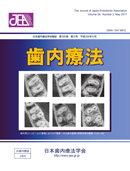Volume 35, Issue 3
Displaying 1-5 of 5 articles from this issue
- |<
- <
- 1
- >
- >|
Review Article
-
2014 Volume 35 Issue 3 Pages 117-124
Published: 2014
Released on J-STAGE: September 30, 2017
Download PDF (1635K)
Original Article
-
2014 Volume 35 Issue 3 Pages 125-132
Published: 2014
Released on J-STAGE: September 30, 2017
Download PDF (5558K)
Clinical Reports
-
2014 Volume 35 Issue 3 Pages 133-137
Published: 2014
Released on J-STAGE: September 30, 2017
Download PDF (673K) -
2014 Volume 35 Issue 3 Pages 138-144
Published: 2014
Released on J-STAGE: September 30, 2017
Download PDF (2650K) -
2014 Volume 35 Issue 3 Pages 145-152
Published: 2014
Released on J-STAGE: September 30, 2017
Download PDF (2771K)
- |<
- <
- 1
- >
- >|
